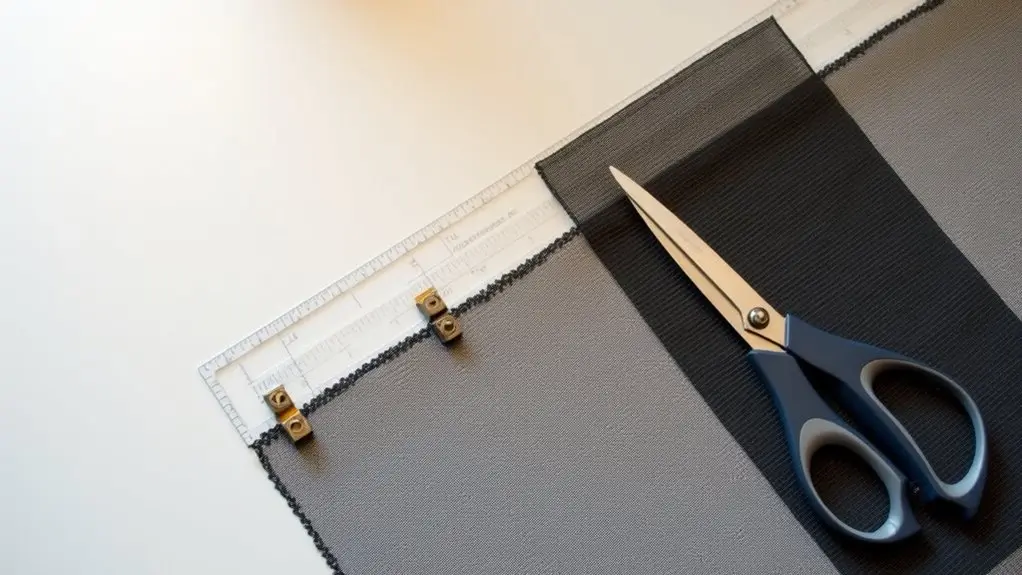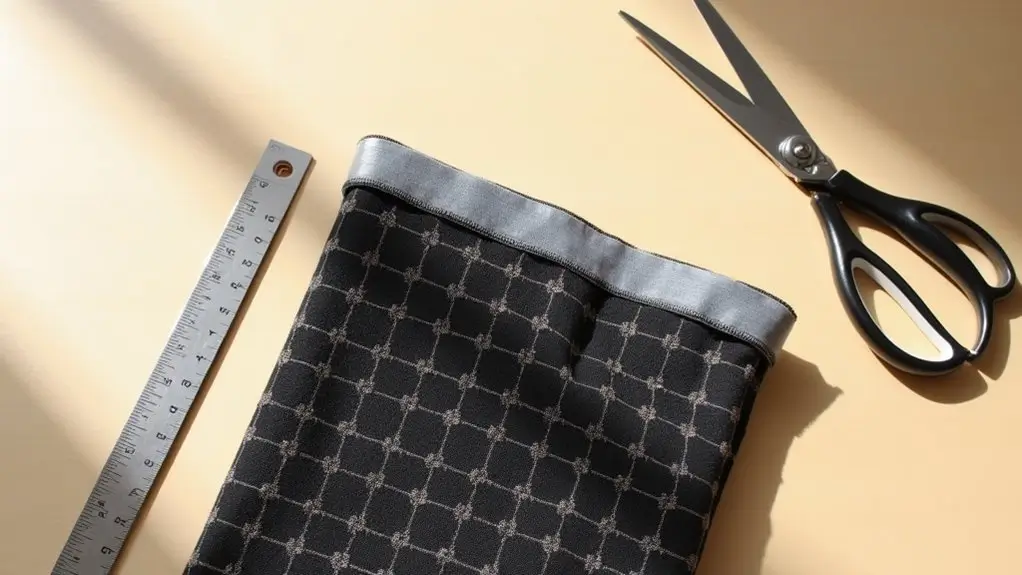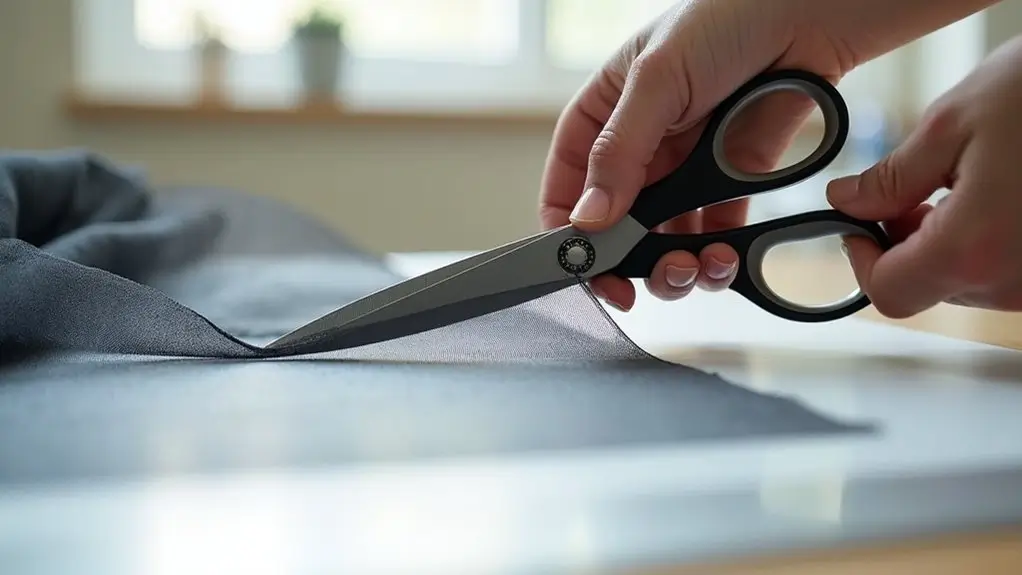If you've ever worked with mesh fabric, you'll know it can be a tricky material to handle. The loose, open weave structure makes it prone to snagging, stretching, and distorting during the cutting process. Without the right tools and techniques, you'll likely end up with uneven edges and damaged fabric that's difficult to sew. But don't let these challenges discourage you—mastering the art of cutting mesh fabric is entirely possible with the proper approach.
Key Takeaways
- Use a sharp rotary cutter with a self-healing mat underneath for the cleanest and most precise cuts through mesh fabric.
- Stabilize the mesh fabric with pattern weights instead of pins to prevent shifting while cutting.
- Cut only one layer at a time and apply steady pressure while following marked lines for professional results.
- Place tissue paper or wash-away stabilizer under mesh fabric before cutting to prevent bunching and ensure smooth edges.
- Choose specialized scissors with micro-serrated blades when rotary cutters aren't suitable for intricate pattern details.
Tips for Cutting Mesh Fabric

Sharp rotary cutters and specialized scissors designed for mesh will give you the cleanest cuts, while pattern weights help prevent fabric shifting during cutting.
You'll achieve precise edges by placing a cutting mat underneath and applying firm, steady pressure as you cut along straight lines or curves.
After cutting, you can stabilize mesh edges with wash-away stabilizer or tissue paper to prevent stretching and distortion during the sewing process.
Best Tools for Cutting Mesh
Selecting the right cutting tools for mesh fabric will determine the quality and precision of your finished project.
A sharp rotary cutter and a self-healing mat provide the cleanest cuts when working with mesh. You'll get neat edges by cutting one layer at a time, applying firm pressure as you roll the blade.
If you're using scissors, choose ones specifically designed for fabric with micro-serrated blades to prevent the mesh from shifting.
Keep your tools clean and sharp to avoid snagging or distorting the material. For intricate patterns, consider using small, precision scissors that allow for detailed cutting around curves and corners.
Techniques for Clean Cuts
Achieving clean cuts with mesh fabric requires a methodical approach and proper preparation. Begin by laying your mesh fabric flat on a self-healing mat, ensuring there's no bunching or wrinkling. Mark your pattern precisely using tailor's chalk, as mesh's open weave can make lines difficult to see.
When cutting mesh fabric, use a rotary cutter with a sharp blade and maintain steady pressure. If you're working with multiple layers, secure them with pattern weights rather than pins.
Apply a gentle touch while cutting, letting the blade do the work - don't force it through the material. Follow your marked lines exactly to achieve professional results.
Handling Edge Finishing
Because mesh fabric tends to fray and unravel easily, proper edge finishing techniques are essential for durability and professional results. After using your rotary cutter and a self-healing mat for clean cuts, you'll need to stabilize the edge immediately.
Place tissue paper underneath to prevent the mesh from slipping and sliding during finishing. Pin the stabilizer strip along the raw edge, ensuring you're working with just one layer at a time.
You can finish the edges using a serged seam, rolled hem, or binding tape. For delicate mesh, consider using a lightweight fusible interfacing before hemming to maintain the fabric's drape.
Sewing Techniques for Beginners

Learning to sew mesh fabric requires mastering both hand-sewing and machine-sewing fundamentals to achieve professional results.
You'll need to select the appropriate needle size, stitch length, and tension settings on your sewing machine, while hand-sewing demands precise backstitch or running stitch techniques with lightweight thread.
To prevent puckering, skipped stitches, and fabric stretching, you'll want to avoid pulling the mesh too tightly and guarantee you're using a ball-point or stretch needle designed specifically for knit and mesh materials.
Sewing Mesh Fabric by Hand
While sewing mesh fabric by hand requires patience, you'll find success by starting with the right tools and techniques.
Choose a sharp, fine needle suitable for delicate materials, and work on a self-healing mat to prevent snagging. Pin your mesh carefully, using ballpoint pins to avoid damaging the fabric's structure.
When hand-stitching mesh, keep your tension consistent but not too tight. Work slowly to maintain control, using shorter stitch lengths for stability.
If you're joining two pieces, align the mesh holes precisely before sewing. For clean edges, consider using a rotary cutter on your self-healing mat before you begin stitching.
Using a Sewing Machine
When setting up your sewing machine for mesh fabric, you'll need to adjust several key settings for ideal results. Install a ballpoint or universal needle, as these prevent snags and runs in the delicate material.
Lower your feed dogs slightly to reduce fabric stretching, and set your stitch length to 2.0-2.5mm for stable seams.
Place a piece of tissue paper under the mesh fabric while sewing to prevent it from getting caught in your standard sewing machine. Test your settings on a scrap piece before starting your project.
If the fabric puckers or stretches, adjust the presser foot pressure and tension until you achieve smooth stitches.
Common Mistakes to Avoid
Even with the right machine settings, beginners often encounter several common pitfalls when sewing mesh fabric.
Don't pull the fabric while sewing, as this can cause it to pucker and create uneven lines. Watch for holes that might develop if you're using too much pressure or the wrong needle size.
Avoid cutting mesh with scissors, which can leave jagged edges. Instead, use a rotary cutter and a self-healing mat for precise, clean cuts.
When joining seams, make sure they're properly secure - loose stitches are a common challenge with mesh. Remember to test your technique on scraps before tackling your main project.
Challenges of Sewing Mesh Fabric

Mesh fabric's loose, open weave structure can make it challenging to control under your presser foot, often leading to skipped stitches and distorted seams.
You'll need to adjust your machine's settings carefully, including reducing thread tension and using a shorter stitch length to prevent the fabric from becoming caught or puckered.
To create clean, professional-looking seams, you'll want to contemplate French seams or enclosed seam techniques that prevent the mesh's raw edges from fraying or catching on other garment elements.
Why It Can Be Hard to Sew
Although mesh fabric creates stunning garments with its open-weave structure, its flexibility and delicate nature make it notoriously challenging to sew. The synthetic material's stretch and open structure require specific techniques and tools for successful projects.
- The fabric's loose weave tends to snag on standard sewing machine needles, requiring you to use specialized needle sizes and polyester thread.
- Mesh's stretchy composition makes it shift and pucker during sewing, causing uneven seams and distorted patterns.
- The open structure can get caught in feed dogs, while cutting requires a rotary cutter and a self-healing mat to prevent fraying and misalignment.
Tips for Overcoming Difficulties
Despite the challenges of working with mesh fabric, you can achieve professional results by implementing specific techniques and using the right tools.
When sewing mesh fabric by hand, start with a fine needle and polyester thread that matches your fiber content. Place tissue paper under the seam to prevent the mesh from catching in your machine's feed dogs. You'll find it easier to control the fabric's stretch this way.
For a clean finish, set your iron to low heat and test on a scrap first.
A beginner's tip: use a roller foot attachment and reduce presser foot pressure. This combination helps prevent mesh layers from shifting during the sewing process.
Finishing Seams Effectively
When finishing seams on mesh fabric, you'll need to select techniques that prevent fraying while maintaining the material's stretch and drape. To sew mesh fabric successfully, choose methods that provide security without adding bulk or restricting movement.
- Apply a narrow zigzag stitch or overlocking stitch along raw edges, keeping the tension loose enough to preserve stretch while preventing holes.
- Use bias binding or fold-over elastic to enclose seams, especially on exposed edges where durability matters most.
- Create French seams by sewing two layers wrong sides together, then folding and stitching again to completely enclose raw edges.
Frequently Asked Questions
Can I Use Regular Fabric Scissors to Cut Mesh Fabric?
You'll need sharp fabric scissors specifically designed for lightweight materials. Regular scissors can snag and stretch mesh fabric. For best results, you should use micro-serrated or rotary scissors to achieve clean, precise cuts.
How Do I Prevent Mesh Fabric From Curling While Cutting?
You'll need to sandwich your mesh between tissue paper or stabilizer sheets before cutting. Pin them together securely, and use pattern weights to keep everything flat. Don't skip this step - it prevents curling.
What Type of Cutting Surface Works Best for Mesh Fabric?
You'll want to use a self-healing cutting mat with a non-slip surface. Make sure it's smooth, flat, and clean. Alternatively, you can use a rotary cutting board specifically designed for delicate fabrics.
Should Mesh Fabric Be Washed Before Cutting and Sewing?
You'll want to pre-wash your mesh fabric to prevent future shrinkage and remove any sizing chemicals. Use cold water and gentle detergent, then air dry completely before cutting to maintain the fabric's shape and dimensions.
How Much Seam Allowance Should I Add When Cutting Mesh Fabric?
You'll need to add 1/2 to 5/8 inch seam allowance for stable mesh fabrics. For stretchy or delicate mesh, increase it to 3/4 to 1 inch to prevent fraying and guarantee secure seams.
Conclusion
Cutting mesh fabric requires precision and proper technique. You'll need a sharp rotary cutter, self-healing mat, and pattern weights to achieve professional results. When cutting, maintain consistent pressure and speed while following your marked lines. Don't skip stabilizing cut edges immediately to prevent fraying. By implementing these technical methods and using appropriate tools, you'll master mesh fabric manipulation and create clean, professional-looking seams.


0 comments